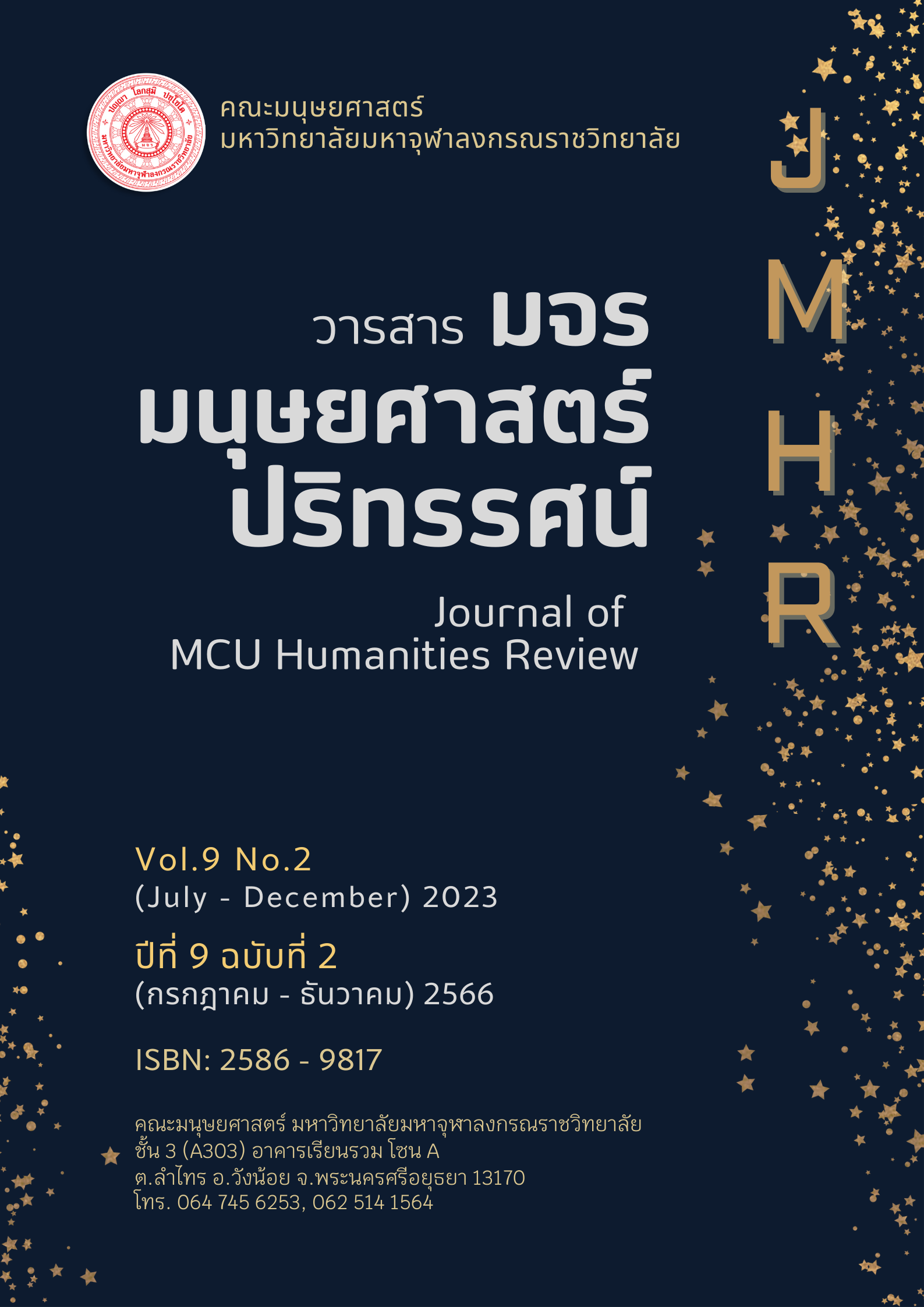รูปแบบการจัดการเรียนรู้รายวิชาพระพุทธศาสนาโดยใชศิลปะเป็นฐานตามแนวพุทธจิตวิทยาของนักเรียนในวัยเรียนช่วงชั้นที่ 3 จังหวัดนนทบุรี
คำสำคัญ:
รูปแบบการจัดการเรียน, พระพุทธศาสนา, ศิลปะเป็นฐาน, พุทธจิตวิทยาบทคัดย่อ
การวิจัยนี้มีวัตถุประสงค์ 1. เพื่อศึกษาการจัดการเรียนรู้โดยใช้ศิลปะเป็นฐาน 2. เพื่อศึกษากระบวนการการการจัดการเรียนรู้รายวิชาพระพุทธศาสนาโดยใช้ศิลปะเป็นฐานตามแนวพุทธจิตวิทยา และ 3. เพื่อนำเสนอรูปแบบการจัดการเรียนรู้โดยใช้ศิลปะเป็นฐานเพื่อพัฒนาผู้เรียนตามแนวพุทธจิตวิทยาในรายวิชาพระพุทธศาสนาของนักเรียนช่วงชั้นที่ 3 เป็นการวิจัยเชิงคุณภาพ โดยใช้แบบสัมภาษณ์เก็บข้อมูลจากผู้ให้ข้อมูลสำคัญ คือ ผู้เชี่ยวชาญด้านการจัดการเรียนการสอนรายวิชาพระพุทธศาสนา ผู้เชี่ยวชาญด้านจิตวิทยา ผู้เชี่ยวชาญด้านสะเต็มศึกษา และครูสอนศิลปะ จำนวน 8 คน เพื่อนำข้อมูลไปใช้ในการสร้างชุดการสอนตามแนวคิดผลการจัดการเรียนรู้โดยใช้ศิลปะเป็นฐานตามแนวพุทธจิตวิทยาในรายวิชาพระพุทธศาสนาสำหรับนักเรียนในวัยเรียนช่วงชั้นที่ 3 จังหวัด นนทบุรี ใช้การวิเคราะห์ข้อมูลเชิงพรรณนา
ผลการวิจัยพบว่า รูปแบบการจัดการเรียนรู้โดยใช้ศิลปะเป็นฐานเพื่อพัฒนาผู้เรียนตามแนวพุทธจิตวิทยาในรายวิชาพระพุทธศาสนาของนักเรียนช่วงชั้นที่ 3 เป็นรูปแบบที่เกิดจากแผนการสอนเรื่องการวาดภาพแบบเซนแทงเกิล (Zentangle) จำนวนชั่วโมงที่สอน 1 ชั่วโมง ผู้เข้าร่วม ได้แก่ นักเรียนชั้นมัธยมศึกษาปีที่ 3 มีสาระสำคัญ (Concept) คือ การวาดภาพแบบเซนแทงเกิล (Zentangle) เป็นการวาดภาพแนวนามธรรมที่สร้างขึ้นโดยใช้ลวดลายซ้ำ ๆ ภาพวาดเซนแทงเกิลจะต้องสร้างขึ้นบนพื้นที่กรอบสี่เหลี่ยมขนาด 3.5 ตารางนิ้ว และจะต้องใช้หมึกสีดำวาดบนกระดาษขาวโดยสามารถใช้ดินสอสีเทาแรเงาได้ การคิดค้นภาพ Zentangle® นั้นมีเจตนาที่จะทำให้การวาดภาพเป็นกิจกรรมสร้างความสุข ใช้ฝึกสมาธิและเข้าถึงได้ทุกคน และวัตถุประสงค์การเรียนรู้ คือ 1) เพื่อให้ผู้เรียนได้เรียนรู้เกี่ยวกับการวาดภาพแบบเซนแทงเกิล (Zentangle) 2) เพื่อให้ผู้เรียนได้ฝึกการวาดภาพแบบเซนแทงเกิล (Zentangle) และ 3) เพื่อให้ผู้เรียนได้ฝึกสมาธิจากการวาดภาพแบบเซนแทงเกิล (Zentangle)
เอกสารอ้างอิง
กระทรวงศึกษาธิการ. (2551). หลักสูตรแกนกลางการศึกษาขั้นพื้นฐาน พุทธศักราช 2551. กรุงเทพฯ: โรงพิมพ์คุรุสภาลาดพร้าว.
ธรรมนิจ ศุภกิจเจริญ. (2561). ประสบการณ์การพัฒนาการตระหนักรู้ตนเองของนักบําบัดด้านการจัดระบบจิตใจผ่านกระบวนการศิลปะเพื่อการเยียวยา (วิทยานิพนธ์วิทยาศาสตรมหาบัณฑิต). มหาวิทยาลัยเชียงใหม่. เชียงใหม่.
พระมหานิรันดร์ ธีรปญฺโญ. (2545). การศึกษาเชิงวิเคราะห์แบบเรียนวิชาพระพุทธศาสนาตามหลักสูตรมัธยมศึกษา (วิทยานิพนธ์พุทธศาสตรมหาบัณฑิต). มหาวิทยาลัยมหาจุฬาลงกรณราชวิทยาลัย. พระนครศรีอยุธยา.
ภัทราพร กงแก้ว. (2563). ผลการจัดการเรียนรู้สาระทัศนศิลป์ เรื่อง ศิลปะสร้างสรรค์โดยใช้โครงงานเป็นฐาน ของนักเรียนชั้นประถมศึกษาปีที่ 5 (วิทยานิพนธ์ศึกษาศาสตรมหาบัณฑิต). มหาวิทยาลัยขอนแก่น. ขอนแก่น.
มารีนา บรมพิชัยชาติกุล. (2546). กระบวนการสร้างสรรค์งานศิลปะในชั้นเรียนของนักเรียนชั้นมัธยมศึกษาปีที่ 3 โรงเรียนสาธิตมหาวิทยาลัยเชียงใหม่ (วิทยานิพนธ์ศึกษาศาสตรมหาบัณฑิต). มหาวิทยาลัยเชียงใหม่. เชียงใหม่.
รุ่งระวี ดิษฐ์เจริญ. (2549). การศึกษาผลสัมฤทธิ์ทางการเรียนศิลปะโดยการสอนแบบบูรณาการด้วยวิธีการเล่านิทานของนักเรียนที่มีความบกพร่องทางการได้ยินระดับมัธยมศึกษาตอนปลายในโรงเรียนโสตศึกษา (ปริญญานิพนธ์การศึกษามหาบัณฑิต). มหาวิทยาลัยศรีนครินทรวิโรฒ. กรุงเทพฯ.
สรัล สุวรรณ และ อุบลวรรณ ส่งเสริม. (2566). การพัฒนาการจัดการเรียนรู้โดยใช้ศิลปะเป็นฐานเพื่อส่งเสริมความคิดสร้างสรรค์ของนักเรียนชั้นมัธยมศึกษา. วารสารวิชาการมหาวิทยาลัยราชภัฏเพชรบุรี, 13(1), 92.
สุภาพรรณ วงศ์ศักดิ์ศิริกุล และ โสมฉาย บุญญานันต์. (2564). แนวทางในการจัดกิจกรรมศิลปะบนฐานทางเลือกเพื่อส่งเสริมการสร้างสรรค์ศิลปะสำหรับเด็กอายุ 9-12 ปี: พหุเทศะกรณีศึกษา. ใน การประชุมครุศาสตร์วิชาการ ครั้งที่ 12. นครศรีธรรมราช: มหาวิทยาลัยราชภัฏนครศรีธรรมราช.
สำนักงานเลขาธิการสภาการศึกษา. (2550). แนวทางการจัดการเรียนรู้จากแหล่งเรียนรู้. กรุงเทพฯ: สำนักงานเขตกรุงเทพมหานคร.
อดิยศ สรรคบุรานุรักษ์. (2559). การพัฒนารูปแบบการสอนโดยใช้ศิลปะเป็นฐาน เพื่อส่งเสริมงานสร้างสรรค์สำหรับนักศึกษาระดับปริญญาตรี (วิทยานิพนธ์ปริญญาปรัชญาดุษฎีบัณฑิต). มหาวิทยาลัยศิลปากร. นครปฐม.
อนุสรณ์ อรรถศิริ. (2549). ความสัมพันธ์ระหว่างพลังความสามารถแห่งตน เป้าหมายและความเป็นไปได้ที่จะกระทำกับแรงจูงใจ (วิทยานิพนธ์จิตวิทยาการศึกษา). มหาวิทยาลัยศรีนครินทรวิโรฒ. กรุงเทพฯ.
อภินภัศ จิตรกร. (2559). การจัดการเรียนรู้แบบศิลปะเป็นฐานเพื่อส่งเสริมความคิดสร้างสรรค์ของผู้เรียนในศตวรรษที่ 21. วารสารศึกษาศาสตร์ มหาวิทยาลัยศิลปากร, 14(1), 64.
Burnaford, G., Brown, S., Doherty, J., & McLaughlin, H. J. (2007). Arts Integration Frameworks Research Practice. Washinton DC: Art Education Partnership.
ดาวน์โหลด
เผยแพร่แล้ว
รูปแบบการอ้างอิง
ฉบับ
ประเภทบทความ
หมวดหมู่
สัญญาอนุญาต
ลิขสิทธิ์ (c) 2023 วารสาร มจร มนุษยศาสตร์ปริทรรศน์

อนุญาตภายใต้เงื่อนไข Creative Commons Attribution-NonCommercial-NoDerivatives 4.0 International License.






